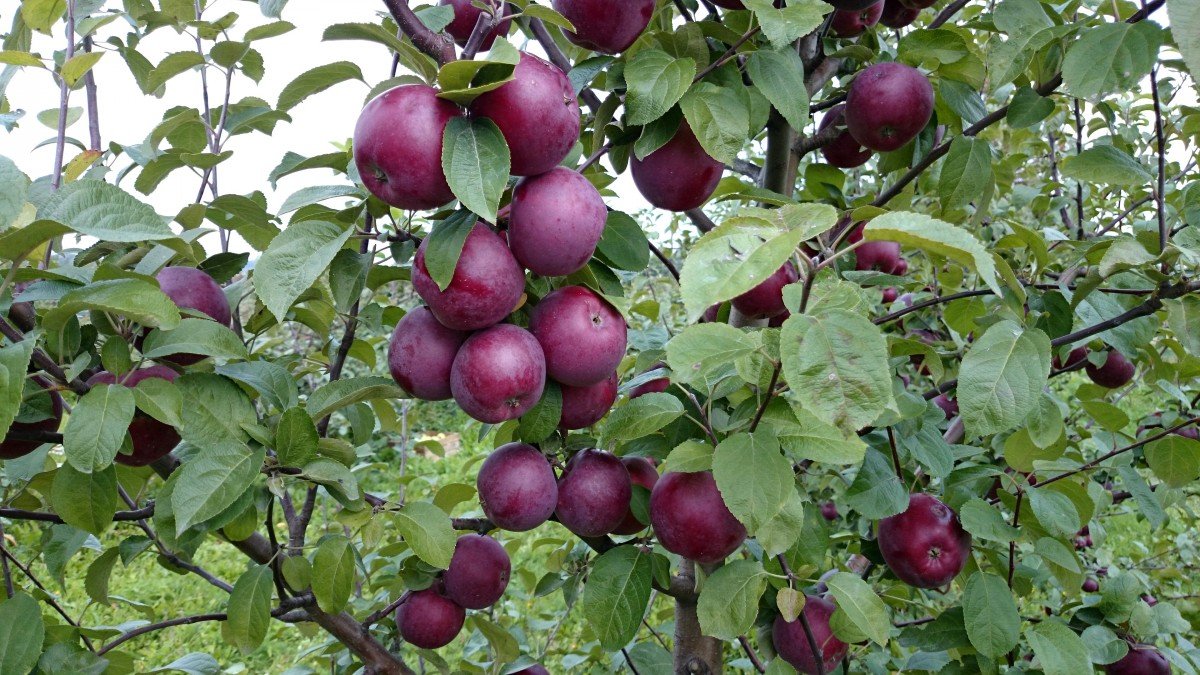Nolina (bokarnea) is a unique plant that is also called the bottle tree. It belongs to the Agavov family. There are about 30 species in the world. This representative comes from the southern regions of America. Nolina is widespread in home floriculture, which is associated with an exotic type of tree and unpretentious care. Such a plant will decorate any interior, but it fits especially harmoniously into the high-tech style.
Content
Interesting facts about nolin
The nolin flower was brought to Russia from Mexico and Texas. The plant quickly adapts to heat and drought, which is due to its tropical origin - it grows mainly in rocky and desert areas. It tends to accumulate solid reserves of moisture in the trunk at the base. Therefore, the tree is able to do without moisture for a long time.
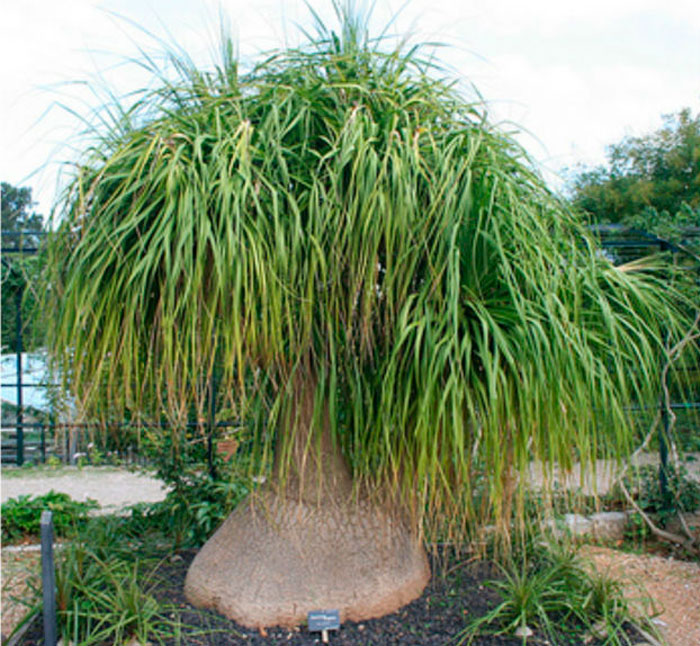
In the natural environment, the bottle tree stretches up to 8 meters, at home - much lower (about a meter). It received this name due to the peculiar shape of the trunk. It is covered with cork-like bark, due to which the tree is popularly called the "elephant's leg".
Home-grown specimens are valued for their high decorative performance. Outwardly, the tree looks like a palm tree, only in miniature. The leaves are dark green, narrow and long in shape (up to 60 cm), forming a bundle-like cap at the top. In artificial conditions, nolina does not bloom... It grows slowly, so for more than one year it will delight households with its outlandish look.
Nolina's leaves are quite sharp at the edges, so you need to be extremely careful when handling the flower.
The shape of the plant can be created individually by selecting the appropriate growing conditions. So, a compact crown is obtained by keeping the plant in a room with dry air, in bright light and with alternating abundant watering with strong drying out of the soil. An elongated trunk, a small bulb on the bottom and a lush leafy component are obtained with diffused light and stable moist soil. The main condition for the stable growth of a plant is to prevent overflow, which leads to root rot.
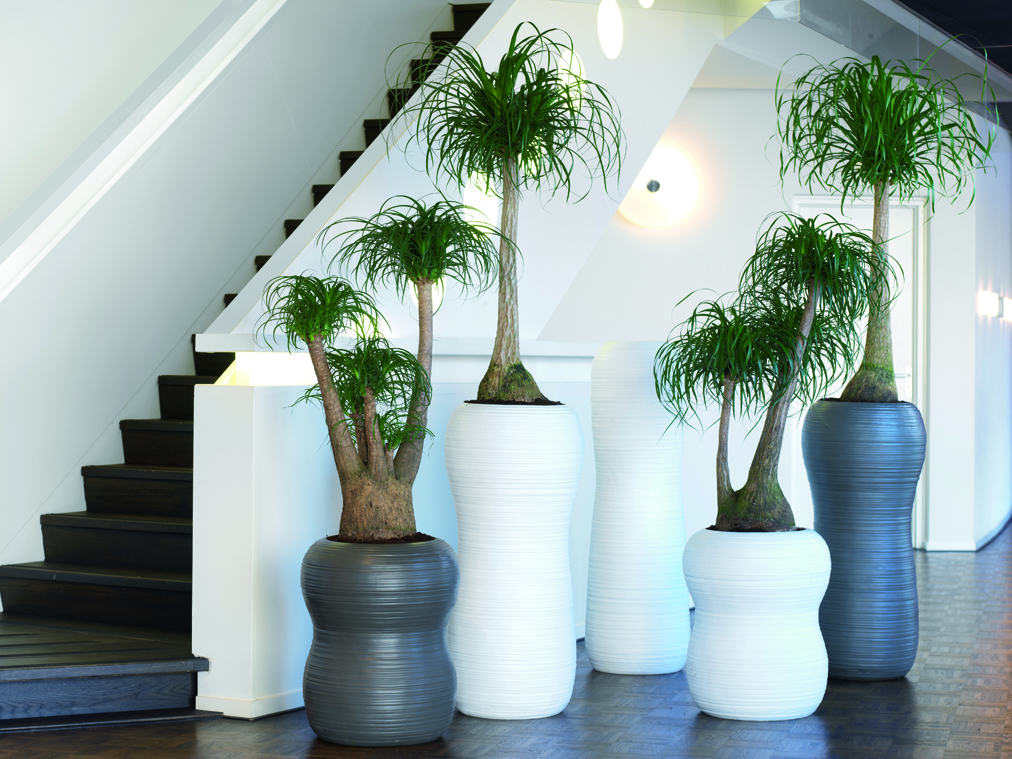
Caring for Nolina at home is simple, but it involves a number of nuances. Even beginner growers can cope with this if they first get acquainted with professional recommendations. Such a tree is considered an ideal option for landscaping the house of those people who are absent for a long time. The succulent plant will not dry out due to its ability to moisturize due to its own reserves. In addition, the plant purifies the air. This is why it is often grown in childcare facilities, hospitals and offices.
Signs associated with sidecarnea
According to the teachings of Feng Shui, all plants influence a person to a certain extent. So, the appearance of a bokarnei in the neighborhood promises those around them only positive changes. The flower brings harmony and calm life to the family. All succulent varieties, including the bottle tree, suppress outbursts of anger and unreasonable rage in humans.
It is recommended to place the flower in the living room or in the corridor - where there are many people.
Types for home cultivation
Here are the most common varieties of nolina for home gardening:
- Peeled back, or recurvata - has a powerful woody stem, one meter in height, covered with gray cork fabric, with sparse branching. Leaves of a leathery structure, linear in shape, collected in a dense rosette at the crown. In its natural environment, the tree blooms with pinkish-cream flower clusters.

- Long-leaved - in nature, the tree stretches up to 4 meters in height. The trunk is covered with dense bark. The crown is divided into two components - the new and the old. The latter forms a fluffy flowing "skirt" that completely hides the base of the pseudopalm tree.
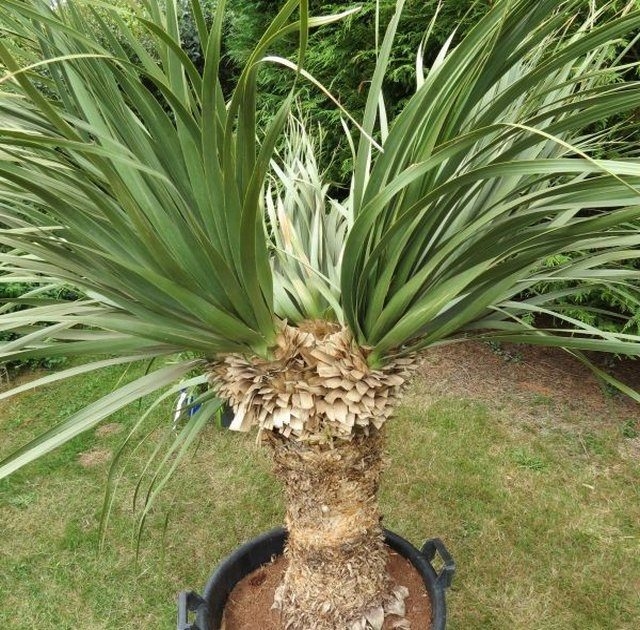
- Lindemeira - undersized type of nolina without a clearly traced trunk. Has elongated narrow foliage.
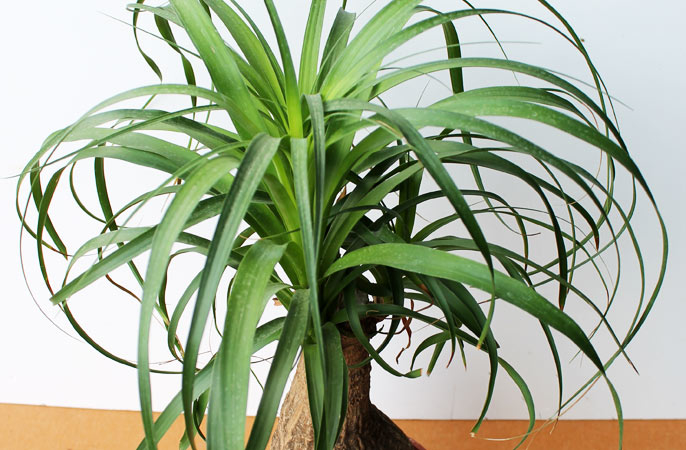
- Stamper - a compact decorative tree with a shortened bottle-shaped trunk. The leaves form a beautiful, compacted crown.
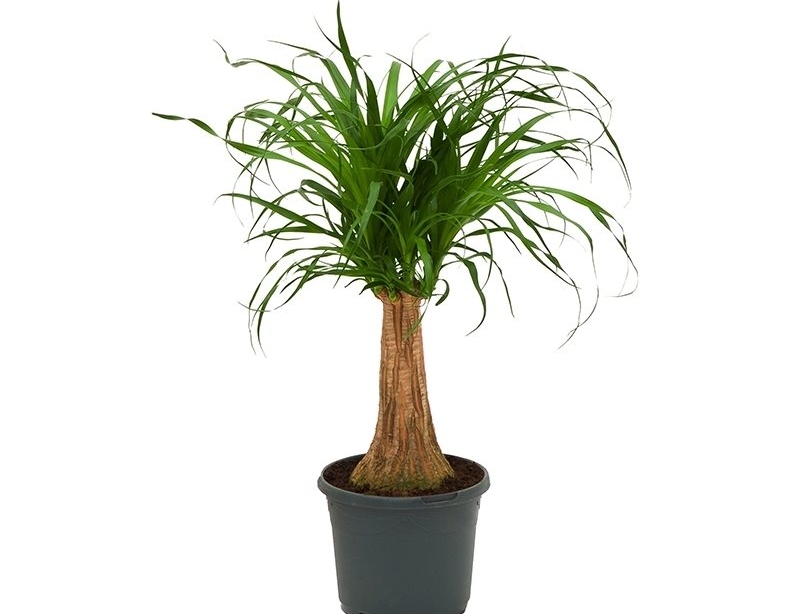
- Matapskaya - grows to a maximum of 1.8 meters. Old leaves do not crumble, but continue to exist, only in the lower tier of the sheaf and in a hanging state.
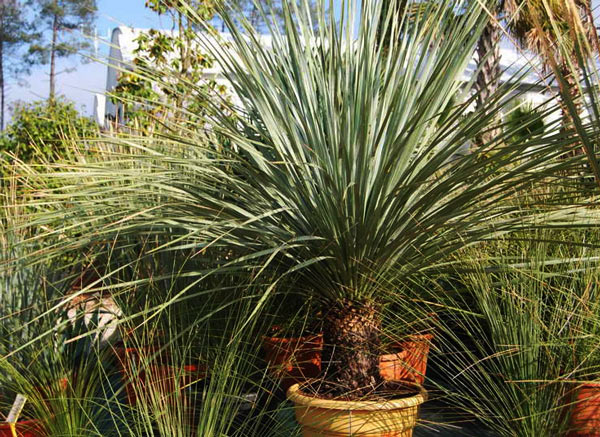
Bocarnea is equally successfully grown in homes and greenhouses.
Planting and transplanting
Before planting a flower, you must select the appropriate pot and soil.... The substrate can be bought ready-made (for agave varieties or cacti) or made independently by mixing peat, fine sand and leafy soil in equal proportions. The transplant capacity is selected wide, since the roots grow close to the surface. The size of the new flowerpot should not be more than 3–4 cm in diameter than the old one.
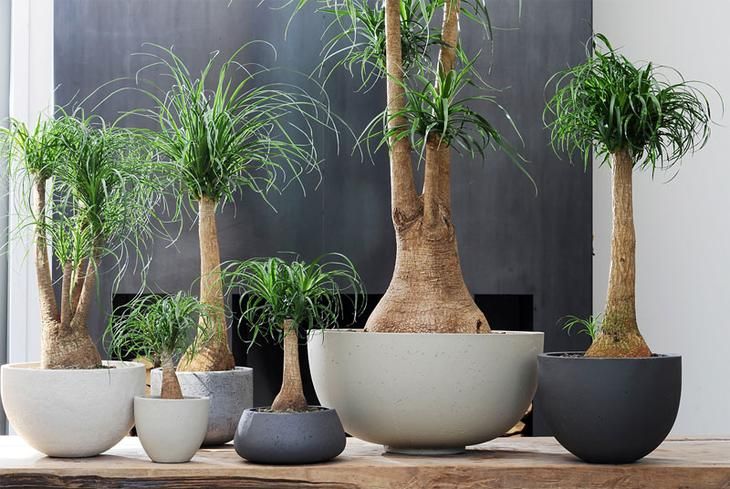
A drainage layer of broken brick, expanded clay, charcoal or small pebbles, 4–5 cm thick, is laid on the bottom of the tank. Only then is the fertile soil filled up and the planting is carried out. At the same time, roots that are very long and tangled are carefully handled. They must first be straightened. After completing the procedure, you cannot water the plant for the next 3 days. This technique helps nolina to take root in a new place easier.
Young plants are transplanted annually, and adults - with an interval of three years. The situation is controlled by the degree of growth of the root system of nolina. If it sticks out through the drainage holes and from above, then the time for resettlement has come.
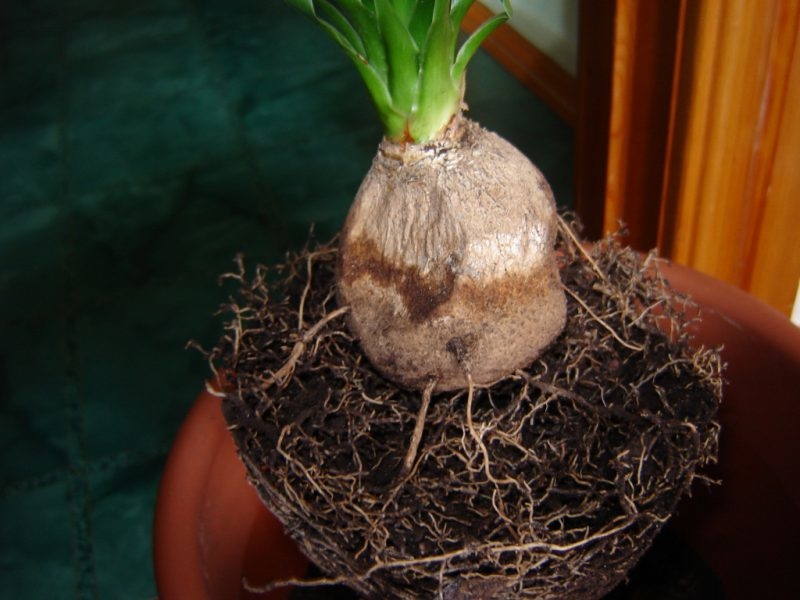
Growing conditions
For the comfortable growth of the bottle tree in room conditions, an appropriate microclimate is created:
- temperature regime;
- lighting;
- air humidity.
The plant is light-loving, therefore, it is placed where there is good illumination all year round, but there is no direct sunlight. It is recommended to place the flower on windowsills with an orientation to the east and west. It is permissible to place it near the southern windows. In winter, Nolina is at rest, but still needs light. Therefore, artificial lighting will be required.
Throughout the growing season (spring - summer), the plant is undemanding to temperature, so the usual indoor plant is suitable for growing. In autumn, it is gradually reduced to + 12 ... 13 ° С. If it is practically impossible to do it, then it is optimal to keep the palm at + 18 ... 19 ° С. Otherwise, the plant will not enter the dormant stage, which will negatively affect development in the future. In summer, the flower is taken out into the garden or on the glazed loggia, but protected from bright rays and drafts.
Plant care
In addition to creating optimal conditions for the plant, it is required to provide it with appropriate care. The emphasis is on proper watering. In the spring and summer, the flower is moistened abundantly, but rarely. Excess water is immediately drained from the pan, otherwise the rhizome begins to rot, and soon the plant dies.
Professional florists recommend watering it using a special technology:
- Pour water into a wide container and place a flower pot there.
- Withstand until the soil is completely saturated with moisture.
- Take out and allow to drain excess water for 30-40 minutes.
Repeat a similar procedure only after the earthen coma has dried. It is not necessary to moisturize nolin during winter rest.
Spraying a plant is an optional care activity. But periodically this is still done while wiping the surface of the sheet plates with a damp cloth. Use boiled and settled water. Pruning is also carried out at will, if they seek to correct the shape of the crown. But even without this, the plant does not lose its decorative appearance.
With good care, bokarnea successfully develops without additional fertilizing. If you want to improve the appearance, it is permissible to feed the tree in spring and autumn with mineral compounds. The concentration indicated in the instructions for use is reduced by 2 times. They resort to this every 17-20 days after watering.
Reproduction
Nolina reproduces by shoots and seeds. Both options have their own nuances that should be considered in order to achieve the desired result.

In the first case, the following sequence is followed:
- A strong and well-developed shoot is selected. Cut off with a sharp knife its part 15–20 cm long.
- The place of the cut is powdered with wood ash and treated with "Kornevin".
- The cutting is buried at an angle into the peat-sand mixture.
- Cover the top with a glass or plastic cap. Rearrange landing in warmth, where there is enough light.
- As soon as new shoots hatch on the shoot, move the container to cool, and then transplant it to a permanent place of growth.
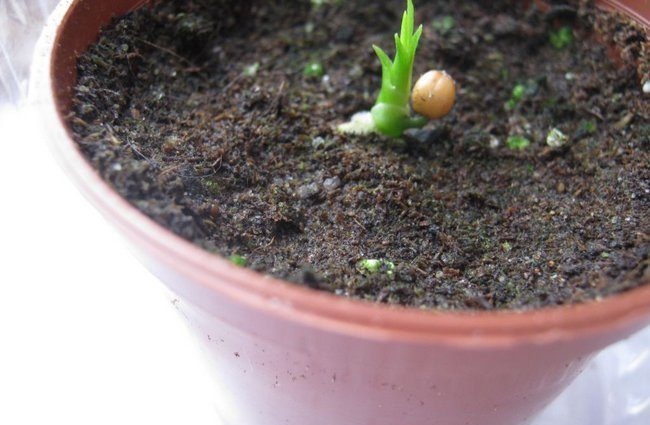
For seed reproduction, material is bought at a flower shop. Previously, it is immersed in a manganese solution of low concentration and kept in it until the seeds swell (usually 2 days are enough). They are sown in soil consisting of peat and river sand, taken in equal proportions.
Sowing is carried out as follows:
- The seeds are deepened into the substrate by 1 cm.
- Cover the seedlings with glass or plastic wrap.
- Place the container in a warm and bright place, where the temperature is kept within + 24 ... + 25 ° C.
- Crops are opened daily for ventilation.
Within a month, the first shoots appear. After they get stronger, they are seated in separate pots.
How do care errors appear?
The most common problems, their manifestations and remedies:
| Signs | Cause | Elimination |
| The tips of the leaves dry up and turn brown | Dry air | Systematically wipe the leaves with a damp cloth and spray |
| The lower leaves dry up | Normal phenomenon | Nothing needs to be done |
| The bulb is wrinkled at the base | Overflow or lack of moisture. With excess moisture, the lower shoots become soft and darken. In case of drought, their color does not change | Stabilize the irrigation regime. If the onion softens, then dig up and cut off the part that has begun to rot. Then sprinkled with charcoal and transplanted into a fresh substrate |
| Growth is inhibited, leaves turn pale | Cramped pot or lack of light | Requires a transplant to a more spacious container |
| The trunk is deformed, dents appear | Individual feature or the result of mechanical impact | If the pits do not increase in size, then nothing needs to be done. Otherwise, it is worth carefully examining the plant for the presence of pests or fungal diseases. |
| The trunk is bent | Uneven incident light | From time to time, the flower is turned so that all sides are fully illuminated |
| Individual leaves darken and begin to dry out | Not enough light | They rearrange the tree where the illumination is better, or organize additional lighting |
Diseases and pests
Nolina is rarely affected by diseases. The main danger is fungal diseases that develop as a result of excessive watering.To save the flower, the rotten roots are cut off, healthy areas are treated with fungicidal preparations for indoor plants.
Insects do not attack nolina so often, which is due to the hardness of its foliage. But the danger still comes from the following pests:
- thrips;
- spider mite;
- shield;
- worm.
Insects attack the plant when the indoor air is too dry. At the same time, the leaves turn yellow intensively, lose their shape and sag.
First, they get rid of parasites mechanically - they are removed by hand. After that, the plant is washed under a stream of warm water. If the lesion is strong, then they resort to spraying with insecticides. A similar procedure is carried out in the fresh air and after putting on gloves on your hands. It is recommended to repeat the treatment after a week.
Nolina is a spectacular exotic tree that can transform the interior of the house. In addition to beauty, it benefits others, as it releases phytoncides that purify the air. If you properly care for the plant, then it will delight with its presence for more than one year.


